| Home |
| Acknowledgments |
| Conventions |
| Glossary |
| Maps |
| References |
| Links |
| Articles |
| Thumbnails |
| Species
list |
| Family |
| Next
species |
Additional Photos
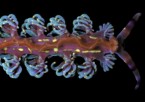
underside
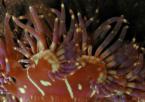
cerata detail

rhinophores
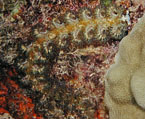
pale

young, about 30 mm
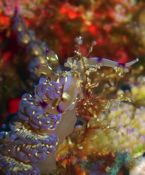
feeding

regenerating
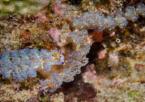
mating

bifurcate tentacle

with egg mass
_______________
GALLERY

Pteraeolidia semperi (Bergh, 1870)
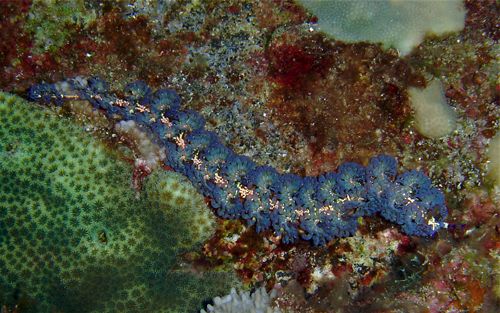
| Maximum size: about 216 mm
(Hoover, 2006). Identification: The body color of this species is translucent tan and the cerata, which in Hawaii vary from dark purple to lavender to golden brown, give the nudibranch most of its apparent color. This is an extremely elongate species with large, curved arches of cerata along the length of the body. The cephalic tentacles have two distinctive dark purple bands. Young animals, however, are much shorter with fewer cerata and are often mistaken for other species. Natural history: Due to its large size and diurnal habits, Pteraeolidia semperi is the most commonly-sighted aeolid in Hawaii. It inhabits moderately protected to exposed rocky locations at 2-55 m (6-180 ft), often near dropoffs. However, it's rare at < 10 m (< 33 ft). It is often observed in its resting posture with cerata laid back exposing the maximum surface area to the sun for photosynthesis by symbiotic zooxanthellae living in its cerata. Protected there, the algae manufacture food and pass a significant amount on to the nudibranch. Individuals vary in color partly due to the number of zooxanthellae in their bodies. It also obtains food by preying on several species of hydroids, including Pennaria disticha, a relatively large and conspicuous non-native species. During digestion, some of the hydroid's nematocysts are retained in the cerata of the nudibranch for use in defense. When touched, the nudibranch will "flare" its cerata and the nematocysts will discharge on contact--it is one of the few nudibranchs with a sting strong enough to be felt by humans (though usually not in areas with thicker skin such as the palm of the hand). It is also able to autotomize the posterior part of its body in order to distract, or free itself from, a potential predator. (Note 1) Later, the missing portion can be regenerated (see photo). It lays a spiral egg mass of convoluted white strands. Distribution: Big Island, Maui, Lanai, Molokai, Oahu, Kauai, Niihau, French Frigate Shoals and Midway: widely distributed in the Indo-Pacific. Taxonomic notes: In Hawaii and elsewhere it is commonly referred to as the "blue dragon nudibranch." It was also referred to as the "blue dragon sea slug" in Hoover, 1997. It was first reported from Hawaii in Zahl (1959) (as Pteraeolidia ianthina). It's also listed as P. ianthina in Kay (1979), Bertsch & Johnson (1981), Hoover (1998) and Hoover, (2006)(corrected in 2019 printing). (Note 2) Photo: PF: Molokini Islet, Maui; Mar. 8, 2008. Observations and comments: Note 1: On July 12, 1994 a Hawaiian swimming crab (Charybdis hawaiiensis) was observed with the posterior half of a P. semperi in its claw. Note 2: Wilson & Burghardt, 2015 found Pteraeolidia ianthina (Angas, 1864) to be a species complex with P. ianthina restricted to New South Wales, Australia. The name Pteraeolidia semperi (Bergh, 1870) was reinstated for the remaining Indo-Pacific populations pending further work to clarify the relationships in the complex. |
| Thumbnails |
Species
list |
Family | Next species | Top |